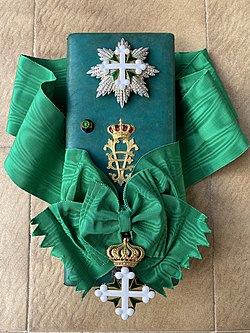This article needs additional citations for verification. (February 2024) |
| Order of Saints Maurice and Lazarus | |
|---|---|
 Grand Cross insignia of the Order | |
| Awarded by | |
| Type | Dynastic order of chivalry |
| Established | 16 September 1572 (Order of Saint Maurice: 1434) (Order of Saint Lazarus: 1119) |
| Royal house | House of Savoy |
| Religious affiliation | Catholic |
| Motto | FERT (Fortitudo Eius Rhodum Tulit; By his bravery he conquered Rhodes) |
| Eligibility | Military, civilian |
| Awarded for | Distinguished merits |
| Status | Currently constituted |
| Grand Master | (Disputed) |
| Chairman of the Council | Emanuele Filiberto, Prince of Venice[1] |
| Grades | Grand Cordon, Special Class Grand Cordon Grand Officer Commander Officer Knight/Dame |
| Website | ordinidinasticicasasavoia.it |
| Statistics | |
| Total inductees | Circa 2,000 |
| Precedence | |
| Next (higher) | Royal Supreme Order of the Most Holy Annunciation |
| Next (lower) | Royal Order of the Crown |
Ribbon bar | |
The Order of Saints Maurice and Lazarus (Italian: Ordine dei Santi Maurizio e Lazzaro) (abbreviated OSSML) is a Roman Catholic dynastic order of knighthood bestowed by the royal House of Savoy. It is the second-oldest order of knighthood in the world, tracing its lineage to AD 1098, and it is one of the rare orders of knighthood recognized by papal bull, in this case by Pope Gregory XIII.[2] In that bull, Pope Gregory XIII bestowed upon Emmanuel Philibert, Duke of Savoy and his Savoy successors, the right to confer this knighthood in perpetuity. The Grand Master is Prince Emanuele Filiberto of Savoy, Prince of Venice, also known as the Duke of Savoy, the grandson of the last King of Italy, Umberto II. However, Emanuele Filiberto's cousin twice removed Prince Aimone, Duke of Aosta claims to be grand master as his father claimed to be head of the house of Savoy.
The order was formerly awarded by the Kingdom of Italy (1861–1946) with the heads of the House of Savoy as the Kings of Italy. Originally a chivalric order of noble nature, it was restricted to subjects of noble families with proofs of at least eight noble great-grandparents. The order's military and noble nature was and is still combined with a Roman Catholic character.
After the abolition of the monarchy and the foundation of the Italian Republic in 1946, the legacy of the order is maintained by the pretenders of the House of Savoy and the Italian throne in exile.
The order is estimated to include about 2,000 members around the world, with about 200 in the United States. The Order also has roster consultative status with the United Nations, as part of the U.N.'s ECOSOC.[3]
- ^ "THE DYNASTIC ORDERS". Dynastic Orders of the Royal House of Savoy.
- ^ "Order of Saint Lazarus: Primary sources" (PDF). um.edu.mt. Retrieved 22 August 2023.
- ^ "About Savoy Foundation". SAVOYFOUNDATION-USA.ORG. Retrieved 22 August 2023.